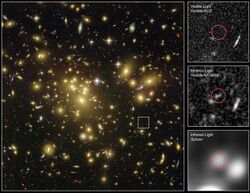Astronomy:A1689-zD1
| A1689-zD1 | |
|---|---|
 Location of A1689-zD1 in infrared and visible light by Hubble Space Telescope and Spitzer Space Telescope | |
| Observation data (J2000 epoch) | |
| Constellation | Virgo |
| Right ascension | 13h 11m 29.9s |
| Declination | −01° 19′ 19″ |
| Redshift | 7.6 |
| Helio radial velocity | 2,278,423 km/s |
| Galactocentric velocity | 2,278,351 +/- 3 km/s |
| Distance | 13 billion light-years (light travel distance) 30 billion light-years (present proper distance) |
| Group or cluster | Abell 1689 |
| Apparent magnitude (V) | 25.3 |
| Characteristics | |
| Type | Dwarf |
| Mass | 1.7×109 M☉ |
| Size | ~3,000 ly (diameter) |
| Apparent size (V) | 0.0008 x 0.0008 |
| Other designations | |
| BBF2008 A1689-zD1 | |
A1689-zD1 is a galaxy in the Virgo constellation. It was a candidate for the most distant and therefore earliest-observed galaxy discovered (As of February 2008), based on a photometric redshift.[1][2]
If the redshift, z~7.6,[3] is correct, it would explain why the galaxy's faint light reaches us at infrared wavelengths. It could only be observed with Hubble Space Telescope's Near Infrared Camera and Multi-Object Spectrometer (NICMOS) and the Spitzer Space Telescope's Infrared Array Camera exploiting the natural phenomenon of gravitational lensing: the galaxy cluster Abell 1689, which lies between Earth and A1689-zD1, at a distance of 2.2 billion light-years from us, functions as a natural "magnifying glass" for the light from the far more distant galaxy which lies directly behind it, at 700 million years after the Big Bang, as seen from Earth.[1]
See also
References
- ↑ 1.0 1.1 "Astronomers Eye Ultra-Young, Bright Galaxy in Early Universe". NASA. 2008-02-12. http://www.nasa.gov/centers/jpl/news/Spitzer20080212.html.
- ↑ "Astronomers Uncover One of the Youngest and Brightest Galaxies in the Early Universe". Space Telescope Science Institute Baltimore, Md. / nasa.gov. 2008-02-12. http://www.nasa.gov/mission_pages/hubble/science/young_bright.html.
- ↑ "heic0805: Hubble finds strong contender for galaxy distance record". ESA/Hubble. 2008-02-12. http://www.spacetelescope.org/news/html/heic0805.html.
 |

